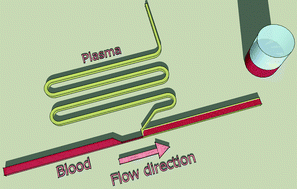High flow rate microfluidic device for blood plasma separation using a range of temperatures
Abstract
A hybrid microfluidic device that uses hydrodynamic forces to separate human plasma from

* Corresponding authors
a
Department of electronics, Physics Faculty, University of Barcelona, C/Martí I Franquès 1, Barcelona, Spain
E-mail:
irodriguez@el.ub.es
b IBEC (Institut de bioenginyeria de Catalunya), C/Baldiri Reixac, 10-12, Barcelona, Spain
c CIBER (Centro de Investigación Biomédica en Red), CIBER-BNN, C/María de Luna 11, CEEI Building, 50018 Zaragoza, Spain
A hybrid microfluidic device that uses hydrodynamic forces to separate human plasma from

 Please wait while we load your content...
Something went wrong. Try again?
Please wait while we load your content...
Something went wrong. Try again?
A. I. Rodríguez-Villarreal, M. Arundell, M. Carmona and J. Samitier, Lab Chip, 2010, 10, 211 DOI: 10.1039/B904531G
To request permission to reproduce material from this article, please go to the Copyright Clearance Center request page.
If you are an author contributing to an RSC publication, you do not need to request permission provided correct acknowledgement is given.
If you are the author of this article, you do not need to request permission to reproduce figures and diagrams provided correct acknowledgement is given. If you want to reproduce the whole article in a third-party publication (excluding your thesis/dissertation for which permission is not required) please go to the Copyright Clearance Center request page.
Read more about how to correctly acknowledge RSC content.
 Fetching data from CrossRef.
Fetching data from CrossRef.
This may take some time to load.
Loading related content
